|
SIX
The Legend of Saint Nicholas and Why Is Santa Ho-Ho-Ho-ing?
Saint Nicholas. Is he more than a memory of a kindhearted man who secretly gave dowries to young maidens? The one who bestowed gifts to the poor making him therefore a renowned figure? Or is he the missing piece to this puzzle. The last cornerstone that makes everything else fit neatly into place?
Saint Nicholas made his way by tales carried down from generation to generation through the efforts of multitudes. Faithful supporters who could not let his spirit die. He was born in Patras, a city of Lycia in Asia Minor nearly three hundred years after Christ's departure. At the age of nineteen he became a priest, then the bishop of Myra during the early fourth century. Nicholas followed in the steps of his father who, too, had been a bishop.
The legends of Saint Nick traveled upstream through the murky waters of our past, and many of them played a magnetic role for his successful popularity. As a child he was known to possess a great and unusual interest in the Scriptures. Other children found their pleasure in childish folly, but Nicholas discovered pleasure in studying the wisdom of God's word. As an adult he gained a great fame for himself with the many miracles he is presumed to have performed. Several are even similar to those of . Christ.
The most remarkable legend might be his trip to the Holy Land when he foresaw a storm demon rushing toward the ship. The sailors aboard were greatly in doubt for the waters seemed calm. Then a storm appeared and the sailors felt hopeless, until Nicholas offered his prayers causing the sea to immediately settle. One sailor slipped while repairing the top of the mast and fell to his death, but Nicholas miraculously restored his life.
Upon his arrival at the church in Golgotha, the doors (mysteriously) opened at their own accord. A sign no less welcoming him into the house of God. Nicholas is also known to have aided in convincing a shipmaster to provide grain for his suffering people while he was in the province of Myra, thus saving their lives.
According to further legend, Nicholas supposedly restored life to several others. There were three young students who had been cruelly butchered and placed in a salting tub by an evil innkeeper. They, too, had Nicholas to thank, but what gave rise to his increasing popularity, making him the most revered of all Christian saints, was his generosity in bestowing dowries to three poor maidens. By Nicholas doing this they were able to marry and, therefore, he saved them from any shame or slavery.
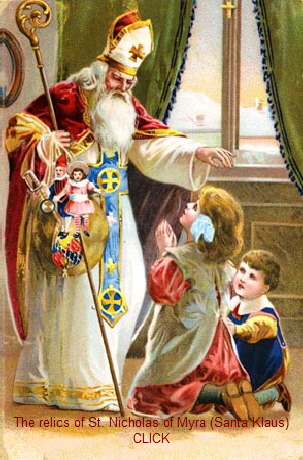 Regardless of whether the stories about raising the dead, calming the sea, feeding the poor are valid or not, the most important realization is that the people of the past believed them. These miracles were so deeply instilled into one's heart that the image of Saint Nick came to be exalted, holding the status of a godlike figure. Regardless of whether the stories about raising the dead, calming the sea, feeding the poor are valid or not, the most important realization is that the people of the past believed them. These miracles were so deeply instilled into one's heart that the image of Saint Nick came to be exalted, holding the status of a godlike figure.
The tales surrounding his life caused the love for him to grow. There is no doubt that this love will continue to be nurtured as long as life itself exists. Saint Nick has become highly revered as a influential force in our world. It has been said that at one time more churches were named after him than all of Christ's apostles combined.
Nicholas is often represented as holding tree purses of gold symbolizing the dowries he gave to the three maidens. The many miraculous tales of his adventures at sea motivated merchants to adopt this symbol as their coat of arms, putting it on their ships. In time the three purses (or three golden balls) became the money lender's insignia. Nicholas thus became the patron saint of bankers, pawnbrokers and mariners, as well as a guardian of young children, maidens, and scholars.
Upon his death on December 6, sometime before A.D. 350, his popularity greatly increased as a worker of miracles (as it did with Jesus). A big feast day on December 6 remains the customary day for sports and gifts to children, most especially in Holland where people fashion themselves to impersonate the bishop. "Saint Nicholas Day" has been popular among the Dutch and Flemish, as well as in Italy where the Feast of Epiphany of January 6, a gift day the Magi, remains popular. In France and Scotland, New Year's Day is preferred, though in France Le Petit Noel is the one who leaves Christmas for the children. In Italy there is a female Santa Claus called Befana. She was the Russian equivalent, Babouschka, before being changed to Grandfather Frost. In England the gift bearer is known as Father Christmas, where the influence of American customs are quite noticeable. In Germany, Christkindl or Christ Child brings the gifts and in Denmark, it is the Yule man. But in America it unquestionably is the beloved Saint Nicholas posing in the image of Santa Claus.
It was six hundred and sixty six years after Nicholas's death when a Russian, Vladimire I, took the deep-rooted love for the saint back to his country. Nicholas was enthroned as the patron saint of Russia, and from there, his name and fame spread to the Lapps and Samoyeds (the reindeer country). Needless to say, the love for him has never ceased.
His popularity was so immense his bones were stolen from their grave in 1087 and taken to Bari, on the heel of Italy. The basilica S Nicola was built to contain his remains. Across the vast seas of the world his fame has been received and, even today, his name remains a household word. It is a name that is adored and humbled and finally glorified in the image of Santa.
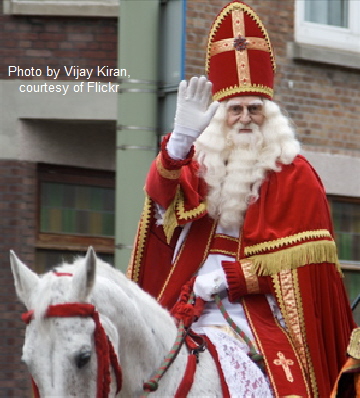 These are just a few of the bits and pieces of the sweeping events that carried the image of this man on his merry merry way. He is a legend for all time. Until the 1800s Saint Nicholas was pictured as a tall, slender figure, stern-faced, staff in hand and riding a white horse. His image slowly transformed into a jolly old fat fellow in a red-trimmed suit, elf like cap, and white beard. His donkey was traded in for a sleigh and his own day of honor (December 6) for the glory seeker of Jesus' birth celebration (December 25). Ever since, he has managed to cunningly divert innocent hearts away from Jesus by luring them to his altar ho-ho-ho-ing al the way These are just a few of the bits and pieces of the sweeping events that carried the image of this man on his merry merry way. He is a legend for all time. Until the 1800s Saint Nicholas was pictured as a tall, slender figure, stern-faced, staff in hand and riding a white horse. His image slowly transformed into a jolly old fat fellow in a red-trimmed suit, elf like cap, and white beard. His donkey was traded in for a sleigh and his own day of honor (December 6) for the glory seeker of Jesus' birth celebration (December 25). Ever since, he has managed to cunningly divert innocent hearts away from Jesus by luring them to his altar ho-ho-ho-ing al the way
Through this imaginary character, Santa Claus, Saint Nick's sprit has become immortal. His generosity in giving gifts to good children and punishing the bad has made him an authoritarian figure. Santa is the center of attention at Christmas time. His game is portrayed as pure fun, a harmless impractical folly. Yet time has revealed that he is far from being pure, let alone harmless.
He has been called many things from Sankt Nikolaus or Kriss Kringle in Germany, to Saint Nikolas or Sinterklaas in Holland. The Dutch thought of Sinterklaas as a rotund little man who wore a typical Dutch costume: garments that included knee-breeches and a broad-brimmed hat. The Dutch settlers brought his image to New Amsterdam (now New York) portraying their love for Nicholas depicted on their ships
After the American revolution, British fashions were losing their appeal as New Yorkers’ began to focus more attention on their Dutch heritage. John Pintard, founder of the New York Society in 1804, was a man who loved holidays. He gathered together what tales and traditions he could redeem about Nicholas then widely distributed them to the public.
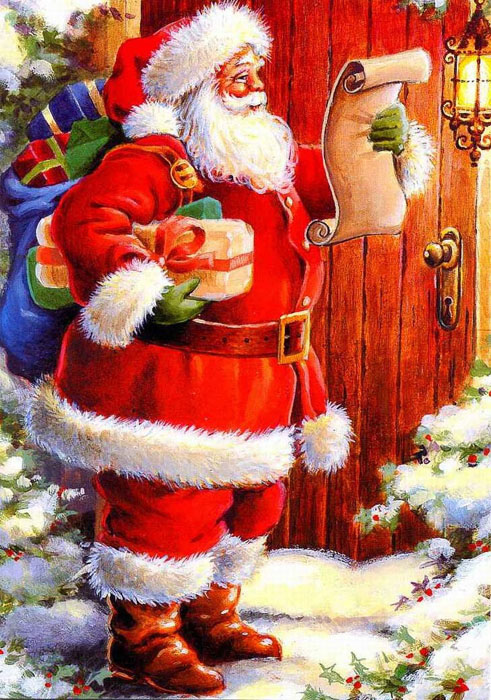 Washington Irving added further details to the Nicholas story when he wrote Diedrich Knickerbocker, a historical account of New York beginning with the roots of the World and ending with the Dutch Dynasty in 1809. It was Irving's constant mention of Nicholas that first introduced many American to a man they had never known. Clement C. Moore, a poet and professor of theology, was captivated by Irving's work and one day wrote the poem, "A Visit fro Saint Nicholas" for his children. This added much to Santa's fame. Moore thought of Saint Nicholas as a "right jolly old elf," and perceived his diminutive size and supernatural powers as a way to come down chimney's bringing tokens of love to all. Moore's poems were published in The New York Book of Poetry in 1837 and have since been loved and cherished. Washington Irving added further details to the Nicholas story when he wrote Diedrich Knickerbocker, a historical account of New York beginning with the roots of the World and ending with the Dutch Dynasty in 1809. It was Irving's constant mention of Nicholas that first introduced many American to a man they had never known. Clement C. Moore, a poet and professor of theology, was captivated by Irving's work and one day wrote the poem, "A Visit fro Saint Nicholas" for his children. This added much to Santa's fame. Moore thought of Saint Nicholas as a "right jolly old elf," and perceived his diminutive size and supernatural powers as a way to come down chimney's bringing tokens of love to all. Moore's poems were published in The New York Book of Poetry in 1837 and have since been loved and cherished.
Santa Claus was on his way to the top but his physical appearance was still unsure in the minds of those who adored him. In 1863, cartoonist Thomas Nast, transformed Saint Nick's image into the image we behold today when he did a Harper's Weekly Christmas layout. Over the next twenty-three years Harper's ran a series of Nast's Christmas drawings and since then little has changed about Santa's appearance, though much has been added to his story. Mrs. Santa Claus was brought to life in 1889 by Katherine Lee Bates in her book Goody Santa Claus on a Sleigh Ride. She later wrote America the Beautiful.
In 1931 the Coca-Cola company hired Haddon Sundblon to do their Christmas advertising campaign, and Santa swept the public off their feet by becoming an adored image for all the eyes of the world to see. In 1946 Rudolph the red-nosed reindeer was reintroduce after World War II, where before this his name was Rollo.  Robert May was the inventor of the red-nosed creature in 1939 when he did a promotional gimmick for Montgomery Ward's in Chicago. Gene Autry recorded a song about Rudolph in 1949 and from then, Rudolph took flight with Santa gaining much praise. Robert May was the inventor of the red-nosed creature in 1939 when he did a promotional gimmick for Montgomery Ward's in Chicago. Gene Autry recorded a song about Rudolph in 1949 and from then, Rudolph took flight with Santa gaining much praise.
There is no mistaking Santa now. He's that charismatic character we fool our children (and ourselves) by saying, “It's all an innocent touch of love". With false illusions we fill childhood memories of Christmas and Santa Claus with moments to cherish for the rest of their lives. This seed is planted in the hearts of following generations and, alas, Santa lives on and on forever - like God.
Though Nicholas and his immortal spirit, disguised as Santa, has not always been the only gift-bearer winning heart-filled devotion from mankind, but by far he is the most popular. If we trace the roots of Northern Germany (where our English language began and four days of our week evolved), we find the Berchta story deeply planted in the cold, dark forests.
Berchta, too, was associated with children. Some knew her as the White Lady while others thought of her as a witch. Whether she was conceived as a bright, shinning, and beautiful woman, or an ugly old figure with a long nose, big teeth and bristling, thick matted hair, she was nonetheless dearly loved. Her feet were known to be huge in order to trample disobedient children. But German mothers still entrusted the souls of their unbapized babies in her care, as well as the safety of their homes.
Berchta rode through the night sky on her pale horse accompanied by a band of elves and spirits. At the years end she was half-welcomed, half feared. A meal was left in her behalf as well as a sheaf of oats for her steed. Berchta left a blessing if all was to her liking, but a curse if not.
The Berchta story strayed far from her beginning roots making her way to Italy where she became known as Befana. She was carried south by wandering Germanic tribes in the fifth century, and later, she gained the love of Christians during the Feast of Epiphany. He name, Befana, comes from Epifania. Italian children have come to know Befana as a tiny misshapen old woman, unattractive and quite dismal in her black attire. On her broomstick she rides from house to house on the eve of Epiphany, but sometimes she enters through a window or slithers down the chimney. Like the rest of the gift-bearers' stories, good children expect a present while the bad must welcome a lump of coal or a bag of ashes. A nifty prank that still continues today.
As heathen customs came to embrace Christian celebrations they entailed some kind of an explanation that world make them significant to the Christian way of life. Traditions holds that on the night the three kings came in search looking for the Christ child, Befana was much too busy to depart with them. When her work was finished, however, she went in search alone. And now Befana is forever in search of the Christ Child.
The tale traveled successfully reaching into old Russia where the gift bearer became Babouschka. The story is the same whether it be from Spain to Africa; the Berchta legends live on. In the tenth century Germans began to transform into a fully Christianized sect and no longer could tolerate the heathen ways. Eventually their praises turned completely toward Christ.
Christkindl, meaning Christ Child, became the gift-bearer and German immigrants carried their love for him to America. Over the course of time, among the many different languages settling in America during that era, Christkindl became Kris Kringle. It was not long after that when Kris Kringle simply turned into Santa Claus. Initially, Kris Kringle came from Norway and his reindeer and sleigh were known to glide over housetops in a manner figurative to Odin's white horse, Sleipnir. This ancient Norse legend portrayed Sleipnir as having eight feet and was the fastest horse in the world.
In Holland and other European countries, the original Saint Nicholas was a rigid gentleman. He would leave a whip in place of toys for naughty children. Or at least threatened to do so. Knight Rupert (Kneht Rupprecht) proceeded ahead of Nicholas making his rounds in the German Black Forest. His mission was to frighten and threaten children with punishment for misconduct.
In America today, and spreading ever more across the world, little of the disciplinarian remains to spoil Christmas for children. The new jovial Santa Claus has lost much of his stern image though out the years, though some parents continue to use Santa threats or bribery to keep a child well-behaved.
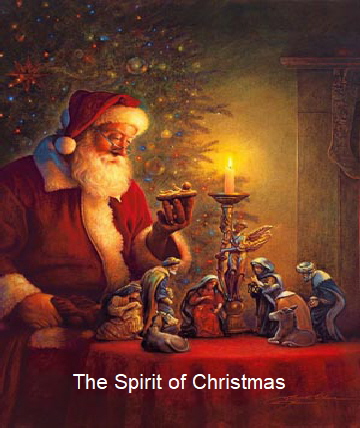 From a tiny little elf of the early 19th century, Santa has blossomed into the beloved impersonation of today. He is very much alive and thriving as the Spirit of Christmas in every sense of the word. It was a long, long, long struggle but Santa Claus has gained his fame as being the gift-bearer and it has been smooth sailing for him ever since. He truly is AN ANGEL OF LIGHT appearing each year to the world as the KING OF CHRISTMAS. From a tiny little elf of the early 19th century, Santa has blossomed into the beloved impersonation of today. He is very much alive and thriving as the Spirit of Christmas in every sense of the word. It was a long, long, long struggle but Santa Claus has gained his fame as being the gift-bearer and it has been smooth sailing for him ever since. He truly is AN ANGEL OF LIGHT appearing each year to the world as the KING OF CHRISTMAS.
There are some churches that have eliminated Santa from their acceptance list, but most continue to tolerate him. The reason for the change stems from the fear of Santa taking top priority over Christ. This has caused a demand for concern that more and more churches are beginning to wonder about.
Those that still allow Santa to be a make-believe game of innocent fun are finding themselves working harder to keep Christ as the center focus. The ones that are becoming leery of Santa haven't quite reached the point of exposing him as no innocent mixture of human folly and Christian devotion. They don't yet have the courage to outright proclaim Santa as the real spiritual threat he is. Perhaps most religious organizations see the same advantage to an old situation: Santa is a means to lure in extra food, clothing, toys, and money for the needy, along with putting a glow a child's face. Perhaps it is better for them to leave well enough alone.
Many organizations use Santa for his great ability to reap in the goods. Very few do not use Santa for one purpose or another. He is a "big hit" and people of all ages have come to love, adore, and worship him. His image over the years has been boastfully portrayed as the all-forgiving Christ-type figure and people have gone to great lengths to show their devotion toward his spirit.
It is a rude awakening when one sees how far mankind has gone to glorify Santa's image. There are license plates displaying as SANTA C. There are two Santa’s in one mall, and while one is handing out traditional candy canes the other has a treat of honest-to-goodness cash. Then there is the Santa who picks up parking tickets, replacing them with a note of reassurance that Santa Claus has intervened, and he kindly extends to them the city's greetings for a Marry Christmas and a Happy New Year. The city treasurer claims that merchants are in favor of it and people think the idea is such a wonderful, pleasant surprise, and they love it. So once again, Santa is a hero.
Breaking out of Santa's traditional arrival in a sleigh, he now makes his grand entrance in many unusual ways, one of which is by water skiing down the icy waters of Oregon. 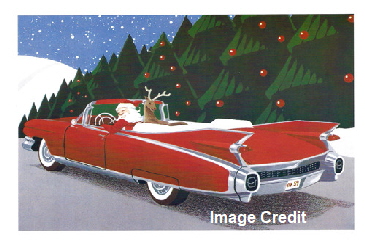 Or by driving a big fancy Cadillac (known as Cadillac Santa), along with his counterpart who arrives in a Mercedes Benz. Together these two Santa’s have discovered a competitive contentment - who can dole out the most money to the homeless. With over three thousand dollars worth of competition going on, the homeless are finding a special gratification of their own in truly believing in Santa. Or by driving a big fancy Cadillac (known as Cadillac Santa), along with his counterpart who arrives in a Mercedes Benz. Together these two Santa’s have discovered a competitive contentment - who can dole out the most money to the homeless. With over three thousand dollars worth of competition going on, the homeless are finding a special gratification of their own in truly believing in Santa.
Of course there is the Santa in the world of Hollywood who makes all the other Santa’s look a big old-fashioned with his modern style. Wearing a Rolex watch, white Reeboks, Cartier eyeglasses, and pulling candy canes of a leather Louis Vuitton bag, here is the Santa of the big stars.
When more than twenty men in Okonite, New Jersey made headlines in their effort to relay the message of keeping the Christmas spirit alive, they conveyed a mighty strong point to ponder. With Santa hats flopped upon their heads, off to work they went crusading for his support. This was, nonetheless, against company policy and it was their willingness to risk their jobs that drew such national attention.
For those who saw this courageous act perhaps they also felt the devotion of these men, as well. Some might have even noticed how Santa is becoming more than fun and games, a means for want, or spreading a little cheer. Possibly they may have even seen how the love for Santa has reached the height of receiving acts of self-sacrifice that only true love can attempt to endure. The pride these men expressed, while holding their picket signs saying WELCOME OKONITE HUMBUGS, seemed evident enough that the humbugs would not dampen their enthusiasm for the spirit.
 In Seaside, California, old-fashioned love is still pouring out from "Santa Claus Lane" to recapture the 1950's when it once swelled with holiday spirit. Now it seems to be a diminishing memory. But the local merchants' infinite hope is to someday revitalize it again. The town folks have not forgotten the good old days when Burl Ives led the Christmas parade in 1979, and neither have many others who still come each year bringing their children to rekindle childhood memories. In Seaside, California, old-fashioned love is still pouring out from "Santa Claus Lane" to recapture the 1950's when it once swelled with holiday spirit. Now it seems to be a diminishing memory. But the local merchants' infinite hope is to someday revitalize it again. The town folks have not forgotten the good old days when Burl Ives led the Christmas parade in 1979, and neither have many others who still come each year bringing their children to rekindle childhood memories.
The idea of Santa Claus Lane itself has never been more booming. The newest approach is The Bear House, The Christmas House, and the Mickey Mouse House. If the Christmas spirit were measured by electrical wattage then the owner of The Mickey Mouse House may score the highest points since he pays one hundred and fifty dollars to power his Disneyland garage. But the owner of The Christmas House requires two extra power lines to juice up his seven-scene display, and it may run close to second place. With more than thirty thousand gawkers and ten thousand candy canes handed out to children each year, these numbers verify that the love for Christmas fantasy will never perish.
Once upon a time, Santa slipped on his attire and the entertainment began. Not much required of him, except a jolly ho-ho-ho and "What do you want for Christmas?" This once seemed good enough but it's not good enough anymore. Now Santa is going to school and training sessions are becoming packed. (Or is it Santa Claus they are packaging?)
From San Francisco, where would-be-Father Christmases dress up in their red and white uniforms, to Philadelphia, where over three thousand would-be-Kris Kingles go to learn how to handle children with a twinkle in their eyes. The Santa Claus business is getting down to business as they practice spreading holiday cheer for department stores and promotional or community events throughout the country. There's no doubt that becoming Santa is becoming a real challenge.
 Each year Santa has his work cut out for him. Finding the perfect gift for every child (and adult) is not always an easy task. But Santa loves animals too, and he makes sure not to forget them on his list. A family pet might find a new toy under the tree but tree or not at the Portland Oregon Zoo one polar bear and his pals were bestowed the ideal gift. It was an extra-tough polyethylene Christmas toy, but this is not all they received. With twenty-four inch rawhide bones and a special meal consisting of salmon and steelhead, the polar bears can indeed praise Santa for having a Beary Beary Merry Christmas, too. Each year Santa has his work cut out for him. Finding the perfect gift for every child (and adult) is not always an easy task. But Santa loves animals too, and he makes sure not to forget them on his list. A family pet might find a new toy under the tree but tree or not at the Portland Oregon Zoo one polar bear and his pals were bestowed the ideal gift. It was an extra-tough polyethylene Christmas toy, but this is not all they received. With twenty-four inch rawhide bones and a special meal consisting of salmon and steelhead, the polar bears can indeed praise Santa for having a Beary Beary Merry Christmas, too.
Material objects are seldom a problem for Santa (unless his helpers can't afford it) but the plea for something more than what money can buy cries out each year. Miracles are on that list and Santa has been known to "pop out" from nowhere to save lives, lift spirits, or grant a dying soul's last wish. It is astounding that Santa gets credit for such things like curing illnesses, reviving the bond of marriage and family, and even restoring a broken heart and soul among the many other miracle requests being made of him. Does Santa hold this kind of power? Many believe that he indeed does while many others are still trying to be convinced.
 The stories are endless in this effort. One heartbreaking headline read, "Two Babies Abandoned on Christmas Day". They were then named Nicholas and Noel (very appropriate for the occasion). Then what about, "Boy Saved by Santa While Choking"? This miracle has been performed more than once. And, "Girl Calls 911 Looking for Santa," was another. The poor little child may not have received any gifts if the police department had not taken it upon themselves to collect toys for her. So good ol' Saint Nick keeps shining for all he has been able to do, yet the best of his marvels remain to be seen in the years ahead. The stories are endless in this effort. One heartbreaking headline read, "Two Babies Abandoned on Christmas Day". They were then named Nicholas and Noel (very appropriate for the occasion). Then what about, "Boy Saved by Santa While Choking"? This miracle has been performed more than once. And, "Girl Calls 911 Looking for Santa," was another. The poor little child may not have received any gifts if the police department had not taken it upon themselves to collect toys for her. So good ol' Saint Nick keeps shining for all he has been able to do, yet the best of his marvels remain to be seen in the years ahead.
All this attention and glorification over Santa's deeds has caused many to plead "Keep Christ in Christmas". Christians are yearning for Christ's miracles to stay alive. Their resentment toward Santa is revealing itself, but believe it or not there are those who actually believe Santa is Christ in disguise. It is a belief that they were taught and are passing on to their children. A belief, perhaps unspoken, yet enforced by some of the highest and respected public figures.
The old saying hold true: Action speaks louder than words. With one of our most powerful men in the world appearing on national television with his picture plastered across newspapers, this was the message he so humbly projected: Santa is sanctioned by God. That highly respected man was the Pope.
In December of 1987, one claiming to be the real Santa met with the Pope to grant him a gift. Although the words themselves may not have been spoken, the Pope's gracious greeting said it all. With a kiss upon the Pope's hand Santa expressed his gratitude for the kindness showed to him among God's elect. He had journeyed all the way from the Finland Laplands (near the North Pole) where he dwells. While this may have appeared amusing for some, it was a very bold message to others. If anyone harbored doubts before they can be sure now: Santa is more than welcome in the house of God.
It ought to make a Christian wonder if something more meaningful is taking place behind these veils of deception that most people accept as innocent folly. Could it be that Santa is taking his official place upon the throne of God? Have these biblical words finally come to pass?
Now concerning the coming of our Lord Jesus Christ and our assembling to meet him, we beg you, brethren, not to be quickly shaken in mind or excited, either by spirit or by word, or by letter purporting to be from us, to the effect that the day of the Lord has come. Let no one deceive you in any way; for that day will not come, unless the rebellion comes first, and the man of lawlessness is revealed, the son of perdition, who opposes and exalts himself against every so-called god or object of worship, so that he takes his seat in the temple of God proclaiming himself to be God.
The coming of the lawless one by the activity of Satan will be with all power and with pretended signs and wonders, and with all wicked deception for those who are to perish, because they reused to love the truth and so be save (2 Thess. 2:1-4; 9-10)
From the moment those words were spoken it has been a mystery to Christians as to who this man of lawlessness will be. God says, "He will take his stand in the Holy Place where he does not belong, showing pretended sighs and wonders". God declared that " people will refuse to love the truth about him, favoring lies". Perhaps what one should be wondering about is if the Antichrist has been right under our nose all along? Perhaps, too, it just may take a rebellion against him, like God declared, before this question is fully answered revealing his true identity.
Keeping this thought in mind, Santa's image has slowly been changing over the years. Besides the endless efforts from numerous individuals, one ad agency has a plan in mind that may very well be "an image overhaul for Santa". The agency has revealed a new project in the works. Santa is about to break out of his six-hundred-year-old tradition from a fantasy figure to a reality figure. And this is just the break he's been waiting for!
According to a poll in 1986, children seemed more familiar with Ronald McDonald than Santa and apparently this disturbed the agency. At least enough to come up with the brilliant notion to fix him up in the twentieth century so he'll be ready to greet the twenty-first century. Their idea may be to slim him down, make him more aggressive, turn him into a hungrier figure who will be in touch with today's goal-oriented generation, but we'll see if and how their quest turns out tomorrow.
This plan that the agency is looking at is toward a more global perspective on promoting Santa. They want to incorporate his name with his new image in order to establish a well-defined figure that can be reinforced worldwide. They feel that even though Santa is known by many names throughout the world, his spirit is one and the same. With this plan in the works, along with the continued efforts of his devotees, including the church's faithful support, perhaps Mr. Claus is on his way to growing even bigger with success and glory.
The price Santa's popularity is costing us is our cherished virtues, upright morals, and precious values. Spiritual treasures that are in constant opposition to the teaching and influences the spirit of Christmas promotes. They are God given gifts rapidly deteriorating in our children as well as in ourselves. Think of how true these words are when one thinks of Christmas: "Where your treasure is, there will be your heart" (Luke 12:34).
In September of 1897, nearly one hundred years ago, an article appeared in the New York Sun titled, "Yes, Virginia, There Is a Santa Claus". This famous, ever-so-sentimental story is so touching that it can almost bring tears to your eyes. It is a story that has deeply cultivated the roots of Santa’s love, generosity, and devotion into the hearts of children, and no doubt has softened the hearts of many skeptical minded over the years. It reminds us, even today, how dreary our world would be without him, leaving us with one last suggestive thought to contemplate. It is a subtle emphasis encouraging us to thank God for Santa with a hope that he will continue to live forever, forever making glad the heart of childhood. The most inspiring and happy ending to such a tale can easily make us forget that before we molded and manipulated the hearts and minds of children, they were scared to death of this man with a hairy face who wears a peculiar looking red suit.
Psychologist are aware of this Santa problem. They realize how stressful and scary the big man in red is to little innocent eyes. The following, extracted from "Making Santa Seem Less Scary," by Don Oldenburg, offers some helpful hints to "make Santa's lap a more comfy place for kids". Some other psychologists, Tedra Walden and Carl Anderson's, suggestions for coping with the holiday visitor from the North Pole include:
|
Read them children's Santa books at home before heading to a department store. Tell them how nice and generous Santa is, or how you looked forward to seeing Santa when you were a child. "Give them the information they need to figure out how to cope," say Walden.
To say simply "Don't be scared" isn't effective. "That just leaves kids scared and feeling it's not all right to be scared, " says Walden. Instead, reassure them that if they are frightened, you are there.
"Sometimes parents are overly respectful," adds Anderson. "They hang back so far that they can't even hear what the kid is saying. It's better for them to stay close."
If necessary, demonstrate the desirable behavior, "We even suggested sometimes that the parents actually sit on [Santa's] other knee," says Anderson. "The photo becomes a family shot."
Don't show indifference or impatience "always makes everything more stressful".
Separate your expectations from your child's - something many parents don't do well, says Walden. "The main expectation parents have is that the kids go along with the program, that they behave appropriately. Parents generally have certain outcomes in mind."
Remember that your child is checking out your reaction to Santa, and that's going to influence his behavior. So don't belittle the event, don't show hesitation, don't give your child negative cues. (Used by permission of the Washington Post.)
|
|
There is no denying that most children fear Santa at first. As they grow older and wiser, they begin to look at him as the one who brings gifts. Only then does their love for him begin to flourish. They have been bought, bribed, and manipulated. Their prayers and wishes are soon directed to him, and even though they one day discover he is a man dressed up in a a costume, they still enjoy the extra gifts in their stocking.
When Santa comes calling in almost every hospital and medical center, depression is replaced with a squeal of delight from all the boys and girls. Laughter fills the air as children rush to his side, clinging to his legs. He sits down next to the brightly lit tree and one by one each child takes his or her place on his lap. This is one of Santa's greatest joys because he feels he is passing along the Christmas spirit of giving and receiving to those who are ill and in need of love. In today's world, that is the important message Santa has for children of all ages - it is the same message Christ pronounced nearly two thousand years ago.
Santa, no doubt, has been winning his status as a deity from the moment of his conception and snatching others' at the moment of theirs. It is an image that has had a long dusty trail to travel but is surely reaping the benefits today. Santa has so many prayers to answer, so many dreams to fulfill. The sick are begging for his healing, the cold and hungry are praying for his kindness to give them warmth and food, children line up by the millions to win Santa's favor to win their favorite toy, and parents tell them little likes to keep the love and faith alive.
Each year the postal services braces for letters that will overflow with the wishes, hopes, and dreams that people send in to have Santa fulfill. In Santa Claus, Indiana, a town with a population of about 514, it is typical in December to receive over five hundred thousand pieces of mail from many parts of the world. According to legend, a group of settles named the town Santa Claus on Christmas Eve in 1852. But in every city and town across this nation and many parts of the world, mail for Santa floods in. Although most of these letters are asking for toys and games, for those who in poverty it means asking for food, clothing, and shelter. Adults, too, seek Santa's good graces. One needs only to read the newspaper or listen to what people say to find out what millions are asking from Santa Claus each year.
|
Dear Santa,
We do not have food and we need clothes to wear. Please help us, Santa.
Dear Santa,
I don't need anything. But my daddy is very sick. Could you please make him better. And could bring me a baby sister.
Dear Santa,
My husband is a drug addict. He has left us with nothing and I can't afford to buy my kids any gifts. If you could bring them just a little something I would be thankful.
Dear Santa,
I am a single woman raising three children on a salary of minimum wage. With everyone buying beautiful gifts for loved ones, it makes me very depressed that I can't afford one present for my children. I have always believed in your miracles.
Dear Santa,
My husband has been out of work for several months and now that it's Christmas, life seems more impossible. My only wish is that my husband will find a job.
Dear Santa,
More than anything in the whole world I want my mommy and daddy back together again. I will never ask you for anything else.
|
|
These kinds of request indicate a bold message that few are taking notice. Something is slowly beginning to manifest itself. Santa is beginning to materialize from a fantasy perspective into a reality perspective, and the efforts to make this happen are way beyond anyone's control. This is how far the situation has grown.
Nonetheless, there is one image that had the right idea. A frivolous car advertisement showed Mr. and Mrs. Claus holding a mug shot! Whoops, Santa got busted! He was scorned as the thief he really is. Of course, Mrs. C said she warned Santa not to steal that deal but what a deal he stole. He traded in his rundown sled for a brand new car. Now, Santa is going to be traveling in style - even if he has to steal to do it. It is a trait that he has had a lot of time practicing and a lot of time to master.
For many, Santa's health secrets are a scientific wonder, according to government scientists. One spokeswoman for the U.S. Department of Agriculture Human Nutrition Research Center, points out that Santa has lived for centuries accomplishing almost impossible feats at Christmas time. Those who are lost in admiration for Santa's robust health, despite having lived six-hundred years, are more than fifty scientists at the center who would love to study him.
In mock conclusion, the particulars of his amazing health and longevity were made public for the first time. They revealed that Santa most likely stores up plenty of vitamin C from eating oranges while making his rounds in Florida or California. That his greatest beauty secret is he lives in the North Pole, eliminating any sun exposure. The strenuous rounds he makes each year makes very good exercise, so all in all, Santa's health does indicate that he is doing very well.
How funny it is that people carry on about Santa as if he were real while all along they say they are only pretending. But is the spirit of Santa pretending? Or is he for real? After a San Francisco court hearing on the case it has been ruled that he definitely is such.
On December 14, 1988, the Court of Historical Review made a ruling in regard to Santa's authenticity. During more than an hour of testimony from both the prosecutor and the defense, the judge listened patiently while anti-Santa evidence demolished his pretense and pro-Santa evidence supported him. It was proven that Santa is linked to the fourth century bishop named Nicholas, once known as Sinter Klass, a saintly figure who brought gifts in colonial New York and appeared in literature, films, and television across the world.
The defense tried to rest its case on the fact that Santa receives mail, thus proving he has a post office and zip code.
The prosecutor argued that having a zip code does not mean he exists. He did not, after all, have a FAX number. Santa was accused of violating labor laws by having people work endless hours with no pay. He was exposed for wearing fur from deceased animals, smoking tobacco, and breaking and entering homes in the still of the night. The end result: Santa has no visible means of support.
The defense countered with his witness. The five-year-old kindergarten student gave such a convincing testimony that the municipal court judge appeared ready to bang down the gavel to close the case. Just then, the prosecutor pulled out its ace in the hole - a young boy took the stand admitting that he had never actually seen Santa before. Who should then appear but Santa himself carrying a potato sack full of presents.
 Claus reminded everyone that he had been bringing gifts all over the world for at least a thousand years. He humbly admitted that he has been paid only with the respect, love, and belief of many different people. He confessed his smoking days are in the past and the fur trim on his coat and hat were fake. He reassuringly denied ever breaking into anyone's home because he was always welcomed. Claus reminded everyone that he had been bringing gifts all over the world for at least a thousand years. He humbly admitted that he has been paid only with the respect, love, and belief of many different people. He confessed his smoking days are in the past and the fur trim on his coat and hat were fake. He reassuringly denied ever breaking into anyone's home because he was always welcomed.
Basing his decision the the 1947 movie ‘Miracle on 34th Street’, the Judge ruled that as long there is love, generosity, and gift-giving there really, really is a Santa Claus.
Is the case closed or is this just the beginning to a new era of further starling events?
(All rights reserved, including the right of reproduction in whole or in part in any form.
Copyright 1990 / ISBN: 0-533-08812-7 / Library of Congress Catalog Card No : 89-90466 (Out-Of-Print)
|